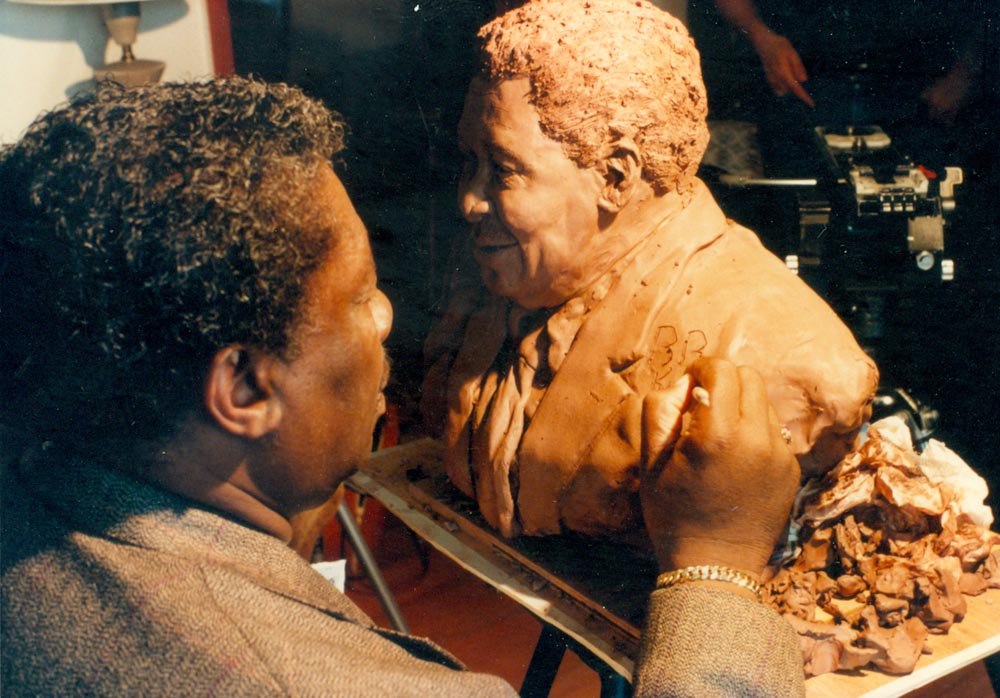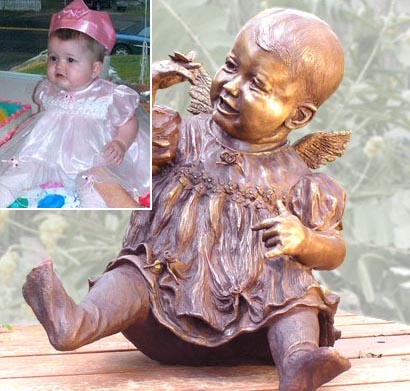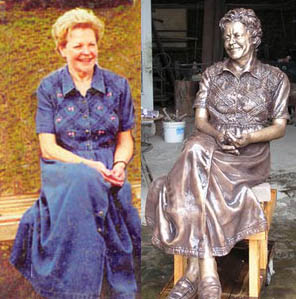
Frequently Asked Questions About Commissions
The process of commissioned sculpture sometimes leaves one with a feeling of awkwardness and confusion. In visiting this section, you probably have decided that you like the style of Bridgette Mongeon's work. That is a great start. We have taken the time to put together this series of frequently asked questions by collectors embarking on their first figurative sculpture commission. If you have other questions please do not hesitate in contacting the artist. She has always said, "The creative process is a lot to understand. Even if you don't choose me, I'd be happy to help you get through the process."
What is a sculpture commission?
A commission is an agreement made between a collector and an artist to create a designated sculpture. Collectors usually chose an artist for their artistic ability and interpretation. Collectors may also consider the artist's reputation and the potential for an increase in the value of their piece as the artist’s reputation grows.
Are there other factors that increase the value of a piece?
Yes. The medium of the piece is sometimes a factor. One-of-a-kind sculptures are often more valuable than limited editions or large editions. The artist’s signature and the number that it is in a limited edition affect the value of a piece. Example: Number one in an edition of 700 (1/700) would be more valuable than 600/700 because it would hold more detail being one of the first pieces coming from a mold. Certificates of authenticity for limited editions may also increase the value of the statue.


When you are creating a sculpture commission, does it take a lot of time with the subject?
With some commissions, the person is not available because of death or distance, and the artist will use the provided reference. But when a subject has a sitting with an artist, it does not take much time. It takes approximately one to two hours with the subject; anything longer than an hour or two, the artist divides into two sessions. Most of this time, she spends photographing and taking measurements. For portrait busts (head and shoulders), the time is often minimal; a full figure takes more time. Unless the artist and the person commissioning know the pose they want the subject to be in, it may take one photo session to try different poses and make a decision. Therefore a second photo session may be necessary. In that sitting, the artist can concentrate on the pose and the details of the hands, feet etc.
If you are sculpting a child or baby, do they have to sit still for this?
No. With small children, Ms. Mongeon spends most of her time on the floor, playing and taking measurements and photographs. She hates sitting still herself, so she certainly would not insist on it with a young person. Besides, being still often inhibits the natural personality of the child from being exhibited. All of her subjects seem to enjoy the sittings, from B. B. King to the babies.
Where does the first sitting take place?
When possible, the artist likes to have the first sitting at the subject’s home. It helps to have them relaxed, especially children. Sometimes when a subject is long distance and unavailable, she will fly to their home. In cases like this, The traveling expenses are built into the contract.
What if I cannot come for the second sitting?
Sometimes photographs or videos can be taken of the sculpture and e-mailed or sent to the client for their approval; however, a final sitting at the studio is the best.
Is that it, just photos and measurements?
No, the second sitting takes place when she feels the piece is almost completed. It is at this point that the subject or client visits her studio. She takes approximately thirty minutes to an hour working around the subject. After this amount of time, she looks to the collector for their input. They may see things that she has missed. One time she remembers feeling she had finished the work, but the mother was just a little hesitant. It was then that they discovered that this young girl was a talker. The artist had sculpted her mouth closed. With a bit of work, Bridgette was able to put those lips into action.


At what size is the sculpture created?
For a portrait bust, yhe artist usually creates them 80% life-size. This is a good size for an average home. Anything larger looks monstrous. The full figure is slightly different; the smallest size is approximately six inches for a seated figurine, but they can be created substantially larger. Life-size is also an option depending on the final medium of the sculpture. The application of the artwork is also another consideration. Will you place it on the mantle, or is it a coffee table piece? Do you prefer to have something to set in the garden or by the pool?
What is better, a full figure tabletop or a bust?
It depends upon the desire of the collector. The important part is capturing the spirit of the subject in the piece. With a full-figure sculpture, many other factors can assist in capturing the personality. For example, Becky loves softball, so a statue is created of herin her jersey, or Elizabeth is forever making her favorite doll dance, and the artist creates that scene in clay or bronze.
In what material is the final piece of art?
There are many options to choose from for the final piece and they depend on the budget of the collector and the application of the art. Fired clay in either white or terracotta is one way of creating a piece of artwork. Most of Bridgette's work is cast in bronze. When she casts a sculpture she loses the original clay in the mold making process. Visit the website pages on the process or look at Bridgette's blog to find out how she does this. If a client desires a sculpture and bronze is not in the budget, there are other materials for them to choose from. Resin or cement are options. Though Bridgette creates in these materials, she does not recommend them. Because of its value, Bronze is the best investment. The nice part about going into the mold process in either bronze or another medium is that the artist can make more than one sculpture. When casting more than one sculpture at a time, it is much less expensive for a second in the edition. Going to a mold offers the collector the opportunity to share the loved one with other people. Example: A mother commissions the pieces and has one cast for each grandparent.
I would like to have more than one child sculpted, should I have them created together?
The artist leaves this to the discretion of the collector. However, the artist often suggests that she create the children separately. The exception to this is if she is creating a limited edition bronze. Commissioned artwork often becomes a family heirloom. With two separate pieces, each child, in adulthood, can have their treasure. The artist can create separate pieces so that they interact with each other. Example: Sarah and Jane are playing jacks. These are two separate companion pieces each with their own pose and jacks. You can display them together on the table to interact and work with each other or separate pieces if you choose. If the artist casts two in the edition at the same time, parents can keep one for themselves. They can cast and give another one to the grandparents knowing it will go to the second child.

Just how expensive is bronze casting?
Bronze casting is an art in itself. The cost of having a sculpture created in bronze depends on the intricacy of the piece and the amount of bronze it takes to make it. There are sculpting fees, mold making fees, and casting fees. Fill out the contact form and the artist can give you some general estimates. After the sculpting, a significant part of the cost is having a mold made. After the foundry or artist completes this mold, they can use it to make future pieces in the edition at a much lower price. If the client likes a bronze, Bridgette can give an estimate on casting more than one before she begins the commission. For example, if she were to cast Chipper in bronze after the sculpting process, the one time cost for the mold would be approximately $800 with an additional charge of $800 for the bronze and each additional bronze.(Chipper is the boy with the bow tie top.)
Do I have to decide now about the final material?
Yes. The final medium of the work affects the design significantly. Some mediums offer more freedom to the artist. It is all in the engineering of the piece. Example: Bridgette can create Suzy balancing on one foot while reaching with a butterfly net in bronze because of the nature of the medium. In clay, it would be almost impossible.


Is there anything else I need to think about concerning this commission?
Yes. Is the piece to be casual or formal? Is there a particular outfit or piece of jewelry that you want the subject to wear? And do you have any snapshots that offer that unique or specific look that you are hoping that the artist can capture — the furrowed brow, strand of hair that always falls over the face, or the crooked smile?
Do you always have to have access to the subject to sculpt them?
Though it is beneficial, it is not necessary. Under certain circumstances, it is not always possible. For example, if the artist is to create the loved one at another time in their life then the age they are now, or if they are inaccessible because of distance or death. Bridgette requests as much reference material as possible. Receiving as many photographs and videos depicting the person from as many different angles as possible is very helpful.
How long does the process take?
The process begins with the signing of the contract. At that time, the collector gives the artist a deposit, and they schedule the first sitting. The artist's schedule for work is determined by the artist's schedule at the signing of the contract and the foundry's schedule. She gives a tentative schedule to the client with the contract. If you are trying to work within a time frame, for example, a birthday, anniversary, or memorial service, please let the artist know. She may be able to work her schedule around your needs.
- Portrait bust and small figurines
- Clay- four to sixteen weeks
- Bronze- four to eight weeks for approval of clay, an additional eight to sixteen weeks for bronze.
- Life-size figures bronze(Clay is not available for life-size pieces; they are only created in bronze.) Eight to twenty weeks for approval of clayand an additional eight to sixteen weeks for bronze.

I have a favorite photo, can you recreate the scene for me?
Certainly, Bridgette has yet to find one that she could not do, or that was not just as inspiring for her. It is a pleasure to make those cherished memories come to life.
I'd like a posthumous memorial sculpture. Is there anything special I need to know?
The artist would first like to express her sympathy for your loss. Posthumous sculpture is one of her specialties. She works with families to grieve and celebrate life. It will be more than a sculpture, it will be a journey celebration.
Do you have payment plans?
Yes, there are many different ways to work out the payments. Typically payments are made in thirds- one third upon signing of the contract, one third upon approval of the sculpted piece, and the remaining balance upon notification that the sculpture is complete. Tax, delivery, and installation, if applicable, are added to the final payment.
I belong to an organization that gives awards. It would be great to have a personalized award. Can you create such a thing?
Yes. The artist has done this for other organizations. Some want to purchase several designs created specifically for their organization. Others have commissioned her to create a design; they give it as an award and also sell it to interested parties. This opportunity has great potential as a fundraiser for the organization.
From time to time an organization will hire the artist to create a specific commission, say of a donors child or grandchild, and the will give that as a thank you or "award" for a patrons participation.
Can I follow along with the sculpting process?
That is the exciting part. The artist usually documents the work on her blog. So, not only can you keep up with the progress of the sculpture, but friends and relatives all over the world can often watch the creation come to life. If you are trying to raise funds and you would like the artist to contribute her blog posts to increase awareness she can do that as well. In some instances she has worked with organizations and schools to create an educational element to the blog posts.
How do I begin?
You can fill out our contact form detailing what you would like and the artist or one of her reps will call you. You can also do the following to assist in moving forward with this collaborative work of art.
- Pull together some images of the subject. Is there a special look or stance that you like?
- At what age do you want them sculpted?
- Do you want a portrait bust, figurine, or life size?
- In what medium are you wanting the sculpture to be created?
- What is your time frame for this project?
- Are there other examples of things you like that you can send links to the artist.

Check Out the Next Steps in the Process...
There is a lot to think about when commissioning an artist, but Bridgette is here to help. Together you will create a family heirloom and masterpiece.








